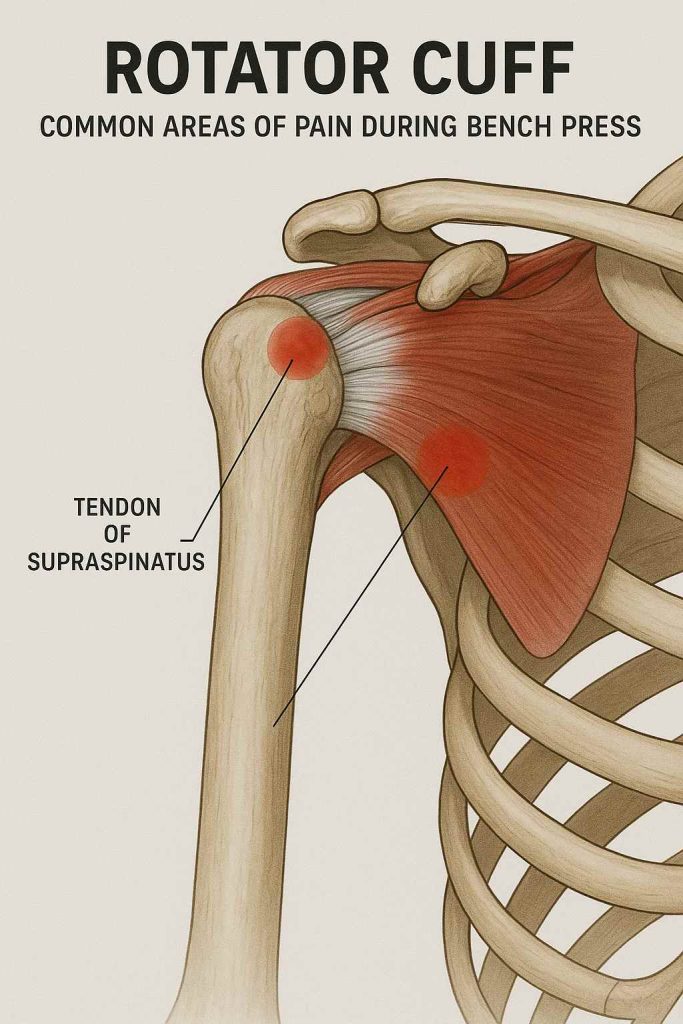Shoulder pain when bench pressing is a common problem, often caused by poor form, weak stabilizer muscles, or underlying shoulder conditions, but it can almost always be fixed with proper adjustments.
If you’re feeling shoulder pain during your bench press, you’re not alone. Bench pressing is one of the most popular strength exercises, but it’s also a leading cause of gym-related shoulder injuries. Knowing what’s happening—and how to fix it—can help you prevent further damage and get back to safe, pain-free lifting.
In this article, you’ll quickly learn:
- The main reasons why shoulder pain happens during bench press
- Step-by-step solutions based on the latest sports medicine research
- How to modify your workout for instant relief and long-term shoulder health

For more info on lifting safety, check the American Academy of Orthopaedic Surgeons Shoulder Pain Resource and the Barbell Rehab Official Bench Press Guide.
Why Does My Shoulder Hurt When I Bench Press?
Most Common Causes
1. Poor Bench Press Technique
- Flared Elbows: If your elbows are out at 90° (straight out from your sides), your rotator cuff gets overloaded, increasing the risk of impingement and pain.
- Wide Grip: Studies show a grip wider than 1.5x shoulder-width puts more stress on your shoulder joints and pec tendons.
- Lack of Scapular Retraction: Letting your shoulder blades “float” (not pulled back and down) reduces shoulder stability and increases strain.
2. Weak Rotator Cuff or Scapular Muscles
- If your rotator cuff or mid-back (scapular stabilizers) are weak, your shoulders can’t stabilize the bar properly, leading to excessive motion and pinching inside the joint.
3. Mobility Issues or Shoulder Impingement
- Tight chest, lats, or shoulders (from sitting, past injuries, or overuse) can reduce your range of motion, making pain or “pinching” much more likely when pressing.
4. Overuse & Poor Recovery
- Too much pressing volume or not enough rest can cause tendonitis, inflammation, or chronic pain. Heavy benching multiple times a week without adequate recovery is a top reason for shoulder injuries.
5. Underlying Shoulder Injury
- Old injuries like a SLAP tear, rotator cuff tendonitis, or mild shoulder instability may flare up during bench press—sometimes without obvious symptoms until the pain appears.
How to Fix Shoulder Pain When Bench Pressing
1. Improve Your Bench Press Form
- Tuck Your Elbows: Keep elbows at about 45–70° from your sides (not flared out).
- Grip Width: Use a grip between shoulder-width and 1.5x shoulder-width—never excessively wide.
- Bar Path: Lower the bar to your lower/mid chest and press up at a slight angle toward your face—not straight up.
- Scapular Retraction: Pinch your shoulder blades together and “down” into the bench before each rep. Hold this tight throughout the set.
- Foot Position & Arch: Keep feet flat, slight lower back arch, and maintain full-body tension for stability.
For visuals, see Barbell Rehab’s Shoulder Pain Bench Press Tips and this guide from E3 Chiropractic.
2. Strengthen Shoulder Stabilizer Muscles
- Rotator Cuff: Add external rotation, face pulls, and “band pull-aparts” 3x/week to your routine.
- Upper Back: Train rows, reverse flys, and scapular push-ups to balance chest pressing.
- Include “prehab” moves: Add YTWs, cable face pulls, and banded external rotations as warm-ups.
- Real-World Example: Research shows that people who train their rotator cuff have a 30–50% reduction in shoulder injury rates compared to those who don’t (PMID: 31335324, 2023 review).
3. Improve Shoulder Mobility and Warm-Up
- Mobility Drills: Do banded dislocates, doorway stretches, and foam rolling for the pecs and lats.
- Activation: Use lightweight bands for 1–2 sets of internal/external rotations and shoulder taps before pressing.
4. Modify Your Workout Plan
- Alternate Tools: Switch to dumbbells, neutral-grip bars, or floor press if straight barbell bench causes pain.
- Reduce Volume: Temporarily decrease bench press frequency to 1–2x per week, and keep sets below failure.
- Balance Your Program: For every pressing set, add a pulling/rowing set to maintain shoulder balance.
- Gradual Progression: Add weight slowly—never increase more than 5–10 lbs per week for pressing.
FAQ: Common Questions About Shoulder Pain When Bench Pressing
Should I stop bench pressing if my shoulder hurts?
A: If you have sharp, stabbing pain, stop and assess—never push through! For mild soreness, try the form, mobility, and prehab changes above. Persistent or severe pain? Consult a physical therapist or sports medicine doctor.
Can I bench press with a shoulder injury?
A: Always get cleared by a pro first. You may be able to use dumbbells, a neutral grip, or floor press safely if cleared, but never work through acute injury pain.
What’s the fastest way to fix bench press shoulder pain?
A: Improving your form (especially scapular retraction and elbow tuck) and adding daily rotator cuff work often brings relief within 2–4 weeks.
Conclusion
Don’t let shoulder pain hold back your bench press progress.
With the right tweaks to form, proper warm-up, and a balanced training plan, most lifters can bench pain-free for life.
Take action:
- Fix your technique today
- Add rotator cuff and upper back work
- Listen to your body and progress gradually
